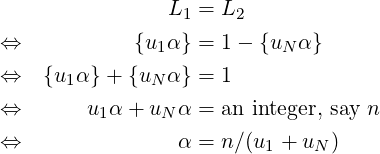
[This page is auto-generated; please prefer to read the article’s PDF Form.]
For i = 1,2,…,N − 1, let us refer to the distance from {uiα} to {ui+1α} as gap-i. The distance from 0 to {u1α} can be referred as gap-0, and that from {uNα} to 1 can be referred as gap-N. Trivially, gap-0 and gap-N are {u1α} and 1 −{uNα} respectively.
Consider some gap-i such that ui lies in interval (b) of theorem 1. Then,

Say, f = {u1α} + 1 −{uNα}, which is the sum of gap-0 and gap-N. So, 0 < f ≤ 1. Then,

Thus, in case when ui lies in interval (b), gap-i is {ui+1α}−{uiα} = {u1α}+1−{uNα}. Similarly, we can prove that when ui lies in intervals (a) or (c), gap-i is {u1α} and 1 −{uNα} respectively.
Note that uN, which corresponds to gap-N, also falls into the range of interval (c). Now we can conclude the following about all of the N + 1 gaps, including gap-0 and gap-N. We count the number of ui integers in each of the three intervals.
Theorem 2. Among the total N+1 gaps, there are N+1−u1 gaps of length L1 = {u1α}, N+1−uN gaps of length L2 = 1−{uNα}, and uN +u1−(N+1) gaps of length L1+L2. The gaps of length L1+L2 exist iff uN +u1 > N +1.
Can the gap-lengths L1 and L2 ever become equal? It can be proved that they will always be distinct for irrational α. Assuming they are equal:

Corollary 3. For irrational α, the gap-lengths L1 and L2 are never equal. So, when gaps of length L1 + L2 exist, there are three distinct gap-lengths, otherwise two distinct gap-lengths.
We have seen how the length of all gaps are related to u1 and uN. The next section presents a theorem which relates u1 and uN to the Continued Fraction of α.
Copyright © 2020 Nitin Verma. All rights reserved.